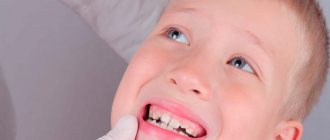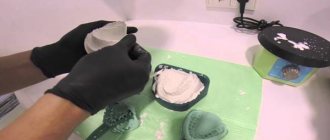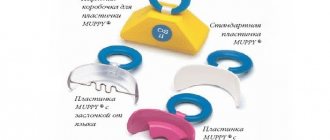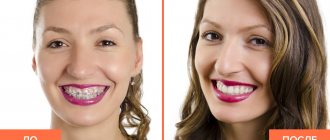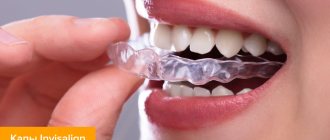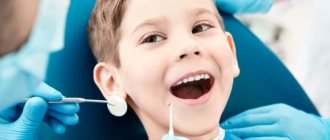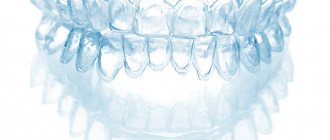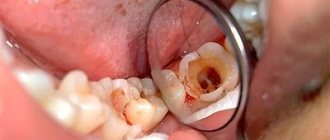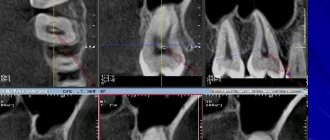10347
In orthodontic practice, special devices are quite successfully used to correct severe bite defects.
This is especially true in cases of mesial anomaly. Face masks are devices with two support clamps. As a rule, one is attached to the frontal part of the head, the second to the chin.
The Dilyar mask is a popular design of this type. Effectively aligns the position of the dentition. The arc is attached to the organs using threads that provide the necessary tension force and control the reliability of the device.
Indications
The device belongs to non-oral dental models; the need for their use is determined by the following indications on the recommendation of a specialist:
- mesial deviation of the bite with a pronounced anterior position of the lower element of the jaw row;
- correction of abnormal tooth fragments;
- inhibition of development and growth of one jaw relative to the other;
- as an additional therapy option when undergoing a course of treatment with braces.
As a summary
Despite the solid theoretical basis and practical results obtained with the use of devices of this type, not all practicing orthodontists approve of this method of correcting dental pathology.
Fixing the device on the chin, according to some experts, leads to rotation of the lower jaw with elongation of the face along the vertical axis.
In this regard, new modifications of orthodontic masks with a lower area of fixation on the neck (in American models) are being developed, which leads to greater efficiency of the method. There are also complaints about the inconvenience for the patient that occurs when wearing the device.
Nevertheless, the method exists and demonstrates sufficient effectiveness, and this is the main thing.
Contraindications
The main contraindications to choosing this option for eliminating bite defects are:
- age of the patient - the device “works” only with children and adolescents, in whom the structure of the maxillofacial apparatus is not yet fully formed, and the bone tissue is susceptible to changes in the direction of growth;
- chronic diseases of the brain, disruption of the vestibular apparatus;
- respiratory dysfunction;
- mental disorders, epilepsy;
- hypertension in the acute stage.
It is worth noting that despite the rather extensive list of prohibitions on wearing the product, the pathologies listed above are quite rare in childhood.
This practically does not limit the use of the device for the correction of malocclusions.
Causes of malocclusion
The human dentofacial apparatus develops over a long period of time - starting from the embryonic period (5th week of pregnancy) and ending with the age of formation of a permanent dentition (18-20 years).
During the period of intrauterine development, the appearance of anomalies of the dentofacial apparatus is influenced by only 2 factors: the state of the mother’s body and genetic predisposition. After childbirth, external factors come to the fore. These include:
- Bad habits - sucking fingers, lips, hard objects;
- Improper organization of artificial feeding;
- Lack of vitamins and microelements in food;
- Prolonged absence of nasal breathing.
Advantages
Due to the specific design, the Dilyar mask has a number of advantages:
- Only one part of the device is located directly in the oral cavity - the thread, which is also quite easily removed. There are no bulky systems in the mouth that press on the mucous membrane and cause discomfort;
- simple dismantling of the external elements of the device - a specialist only needs to show how to use the device once, and the baby’s parents will be able to do it themselves;
- despite the apparent bulkiness, the product is comfortable to wear and its presence on the patient’s face is practically not felt, the effect of its presence is comparable, perhaps, to the presence of sunglasses on the bridge of the nose;
- with correct and regular use of the mask, a stable and long-term result is achieved - the position of the organs of the jaw row returns to a normal state, and the closure of the jaws occurs fully.
What is the vestibular plate, types and purpose.
Let us consider here in great detail the orthotic device.
At this address https://orto-info.ru/sistemyi-vyiravnivaniya-zubov/kappyi-elayneryi/byinina.html you can see photos of Bynin’s mouth guard.
Tubunger's "Sling"
The principle of operation of the Tubunger mask (in another transcription of Tubinger or Tübinger) does not differ from that for the design developed by Dilyar.
The difference lies only in the details of the design: this is an elastic, but quite hard, sling-shaped overlay for the chin tubercle of the lower jaw and an overlay made of the same material (plastic) for the frontal area of the face.
The pads are connected to each other using two metal rods that form the frame of the product and run along the central line - the axis of the face with a smooth protrusion-arc, leaving free space for the nose.
The system of screw-clamps allows, by changing the distance between the upper (frontal) and lower (chin) pads, to securely fix it to the dimensions of the patient’s face. The transverse bar at the level of the oral opening serves for external fastening of the intraoral rubber traction.
According to experts, unlike the Dilyar mask, where the frame is wider, this design is more “crowded” towards the middle, not providing freedom of maneuver when performing jaw traction, which is its disadvantage.
The device is intended for the correction of maxillodental dystopia, leading to difficulty in performing the chewing function of the teeth and disturbances in the formation of the facial skeleton.
Flaws
The device also has its disadvantages:
- low aesthetic level , due to which the device has to be used exclusively at home;
- a rather long course of treatment - due to the fact that the design is not used around the clock, the effect of its use is somewhat reduced, and the wearing time, accordingly, increases;
- the duration and complexity of adaptation is caused by the massiveness of the structure and the relative limitation of visibility. The person gets the feeling that the device is in the way. At the same time, it distracts the child’s attention from other, more interesting things and actions;
- the psychological factor is the presence of a constant desire to remove the mask, so this aspect of the issue is a mandatory requirement for the success of treatment.
If you follow your desires and often neglect to wear the device, there will be no result.
Reviews
I liked the calmness and good nature of the doctor, and there was no feeling that you were being scolded for your diagnosis.
Since childhood, I have been very afraid of dentists, I think, like many others, but, unfortunately, I had to. I won’t talk about the diagnosis I received; I am still embarrassed that I had such teeth, but I can boldly, responsibly and honestly say that I am now very pleased with the health of my oral cavity and the beauty of my smile. .
I liked the calmness and good nature of the doctor, and there was no feeling that you were being scolded for your diagnosis.
Since childhood, I have been very afraid of dentists, I think, like many others, but, unfortunately, I had to. I won’t talk about the diagnosis I received; I am still embarrassed that I had such teeth, but I can boldly, responsibly and honestly say that I am now very pleased with the health of my oral cavity and the beauty of my smile.
Varieties
Each type of model is characterized by its own range of preferences, and can be recommended in the presence of a certain occlusion pathology.
In addition, this type of orthodontic devices is classified according to the method of fastening and tensioning the thread.
Moreover, absolutely all of the options discussed below belong to the category of therapeutic, mechanically active, orthodontic devices.
Universal mask with chin support
This version of the device is used most often because it perfectly stretches the jaws in the required direction.
With this method of support, the pressing force is concentrated in the area of the upper dentition, which makes it possible to qualitatively correct the mesial bite.
The device stimulates accelerated growth of the upper jaw, which accordingly increases the angle of the lower jaw. The basis of the therapeutic effect is the formation of extraoral traction.
Mask with cheek support
The design provides support fastenings on the forehead and cheeks, with the main fastening force falling precisely on the buccal area.
The device is adjustable depending on the size of the face. The mask is indicated for the correction of excessive crowding of teeth, as well as in the presence of pronounced interdental spaces in the lower jaw, mainly in its frontal area.
Indications for use of the Luri Apparatus and its manufacturing technology.
In this publication you will find characteristics of the Mershon Apparatus.
Follow the link https://orto-info.ru/sistemyi-vyiravnivaniya-zubov/lechebno-profilakticheskie-apparatyi/basharovoy.html if you are interested in the manufacturing procedure of the Basharova Apparatus.
Vertical mask large or small
Made from high-quality alloy steel and indestructible plastic. The choice in favor of such a device is made in case of a removable (in its early stages) or deciduous bite.
It has the main indication – all forms of incisor diocclusion (direct, deep, sagittal). Depending on the completeness of the diagnosis, the size of the structure is selected.
This takes into account the angle of the jaw, its length, width and depth of the jaw apparatus.
Horizontal mask large or small
The scope of application of this type of model is the correction of pronounced mesial occlusion (according to the international classification according to Engle, this is the third class).
Qualitatively corrects the mesial displacement of the molars of the lower jaw row up to one tubercle, as well as when diagnosing sagittal spaces or reverse overlaps of the incisal zone that do not go beyond the 2 mm limit.
Face mask in orthodontics – how it works and in what cases it is prescribed
A facial mask is another orthodontic device, which, along with braces, plates and aligners, is used to correct certain defects of the dentofacial apparatus, in particular to solve the problem of mesial occlusion. This is a special design, which, as a rule, has two supports - in the forehead and chin area, and less often - in the cheek area. Today, orthodontists use various types of such masks, each of which has its own purpose.
Principle of operation
The design features of the device provide convenient two-sided fastening, between which metal arcs are located vertically; their operating principle is quite simple.
If a thread is attached to an arch attached to the chin and frontal area, securely fixing it on the desired tooth, then as a result of such tension the product will be firmly fixed on the face, and the organs to which the threads are attached will gradually align their position according to the given tension trajectory.
The principle of operation of the device resembles the action of a rocker with two support zones. The role of the rocker is played by the thread, which, by creating tension, provides a double result.
By attracting the arc to a person’s face, it will not allow the product to come off during treatment, and at the same time, it has a therapeutic effect on the abnormal organs to which it is attached.
If the child’s age is quite young, only a facebow will be enough, and if we are talking about older teenagers or an adult patient, they are worn in combination with braces, mainly to correct pathologies of the lateral masticatory organs.
Do adults need to correct their bite?
Every qualified dentist will answer this question in the affirmative. Incorrect bite entails:
- significant changes in appearance (chin distortion, early wrinkles, etc.), which cause psychological discomfort;
- disruption of the functioning of the jaw system;
- dental diseases associated with the difficulty of performing daily oral hygiene;
- gastrointestinal diseases caused by improper chewing of food;
- Difficulties in the need for dental prosthetics or implantation.
That is why it is important to cast aside doubts and pay attention to your health by contacting a reliable dental clinic.
Features of bite correction in adults
Undoubtedly, it is better to correct the bite in childhood and adolescence, when active bone growth is observed. However, the problem can also be successfully solved at a later date if orthodontic treatment is carried out according to an individual plan drawn up by an experienced doctor. However, there are points for which the patient must be prepared:
- the treatment process is longer, so it is important to be patient and not expect instant results;
- the techniques used may be uncomfortable for an adult patient. This is due to the fact that you have to work with already formed bone tissue;
- the correction procedure must be approached with the utmost responsibility; in particular, it is first important to replace old fillings and eliminate inflammatory processes, if any.
Bite correction in adults: braces
To correct dental anomalies, braces are most often used. It is believed that they are installed exclusively for children and adolescents, but this is a mistaken opinion. Installation is also possible for patients whose age exceeds 30-40 years. True, the therapy will be longer.
Many patients refuse to have braces installed, considering wearing them uncomfortable. Indeed, if the patient is an adult, the discomfort will be more intense, but this is a temporary difficulty. Also, some are simply embarrassed to wear braces. However, it is important to note that modern designs look quite aesthetically pleasing, and wearing them has even become a kind of trend.
At the moment, there are several most common types of braces:
- metal. The most popular option. The design includes pads, as well as an arc that is attached to them using ligatures;
- lingual. Such systems are internal and therefore invisible. This is a good option for those who are embarrassed to wear braces. In addition, lingual braces are the most effective;
- ceramic. They are attached to the outside, but are made of light material, so they are not particularly noticeable. This is also a good option if it is important to maintain the aesthetics of your smile.
The good thing about braces is that their installation has almost no contraindications. The only thing that is important for the patient to remember is that they require careful care.
Alternative to braces: other devices for correcting bites
If it is difficult for a patient to decide to wear braces, other orthodontic devices can be used. One of the most popular ones is mouth guards.
The duration of treatment with mouth guards is at least 2 years. However, the use of such structures has many advantages:
- easy to remove if necessary;
- are invisible, which reduces the level of psychological discomfort;
- do not cause physical discomfort;
- are easy to care for;
- are safe for tooth enamel.
An alternative to mouthguards are trainers. Such systems can be used in cases where the pathology is minor. The advantage of trainers is their low cost and ease of use.
Correction by surgical method
If we are talking about serious anomalies and pronounced defects, an adult patient may require surgical intervention. The main indications are facial asymmetry and chin dysplasia. Most often, surgery is required for an open bite.
During surgery, the gums and bone tissue are cut, so the jaw is aligned and the teeth are in the correct position. If teeth that interfere with alignment are removed, a denture should be installed in their place.
Terms and rules of wearing
The time period for using the structure is about 3-4 months. More specifically, the treatment period is determined by the specialist, based on the degree of development of the pathology, and the need for the device to influence the teeth and jaw rows.
Since, due to aesthetic imperfections, a person does not have the opportunity to wear the model all the time, it is highly advisable to devote as much time as possible to this process while at home.
You need to try to ensure that the average number of hours per day when treatment is carried out is at least 10-12. This can be achieved if you use the device while you sleep and for several hours while you are awake.
After the device is removed, it must be thoroughly cleaned and hygiene measures taken to care for the oral cavity must be observed.
Duration of treatment with Dilyar mask
The degree of complexity of the defect to be corrected determines the duration of active use of the product. As a rule, this period is about three to four months.
One of the main conditions for the effectiveness of the method used is the systematic, 12-14-hour wearing of the Dilyar mask per day.
The device is stored in a special container where it is placed after hygienic treatment. It comes down to washing the structure in warm water and soap and drying it.
Good treatment results with the Dilyar mask are guaranteed with the correct selection of its model and full compliance with the rules of use.
Price
Depending on the design features of the model and the way it is attached, the cost of such a mask will vary in the price range from 4,000 to 9,500 thousand rubles.
Thus, a universal model with a standard fixation method will cost about 4-5 thousand, and the cost of a large vertical or horizontal version will reach 8-9 thousand rubles.
At the same time, the cost of the services of a specialist who will monitor the treatment ranges from 20-30% of the price of the device itself.
Forecast
The prognosis for the complete elimination of bite defects using this type of orthodontic leveling structures is quite optimistic.
If you follow the specialist’s recommendations and choose the right device option, you can completely get rid of pronounced anomalies after just a few months.
As for small children, the result comes after several weeks of therapy.
The principle of operation of the Dilyar mask and the expected result can be seen in the video.
Petit designs
The device serves the same purpose as the above-described structures - to restore the natural bite and arrangement of teeth in the jaws by creating mesial-horizontal traction.
Its basis is a central steel axis made of round wire with caps at the ends to protect against accidental damage; in the center (at mouth level) there is a steel crossbar with bends or hooks for fixing the elastic (rubber) rod.
In terms of ease of use for therapeutic purposes, it is less preferred by orthodontists than the Dilyara apparatus.
